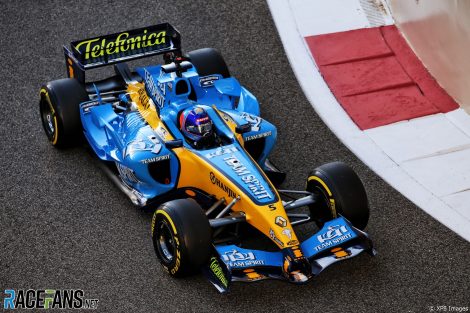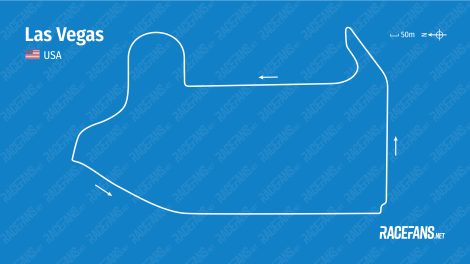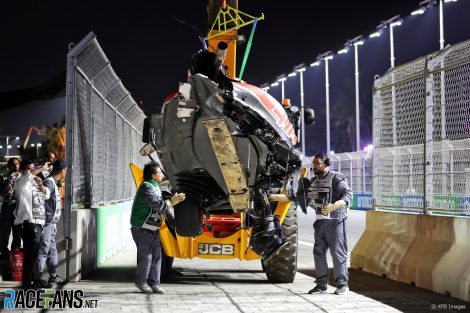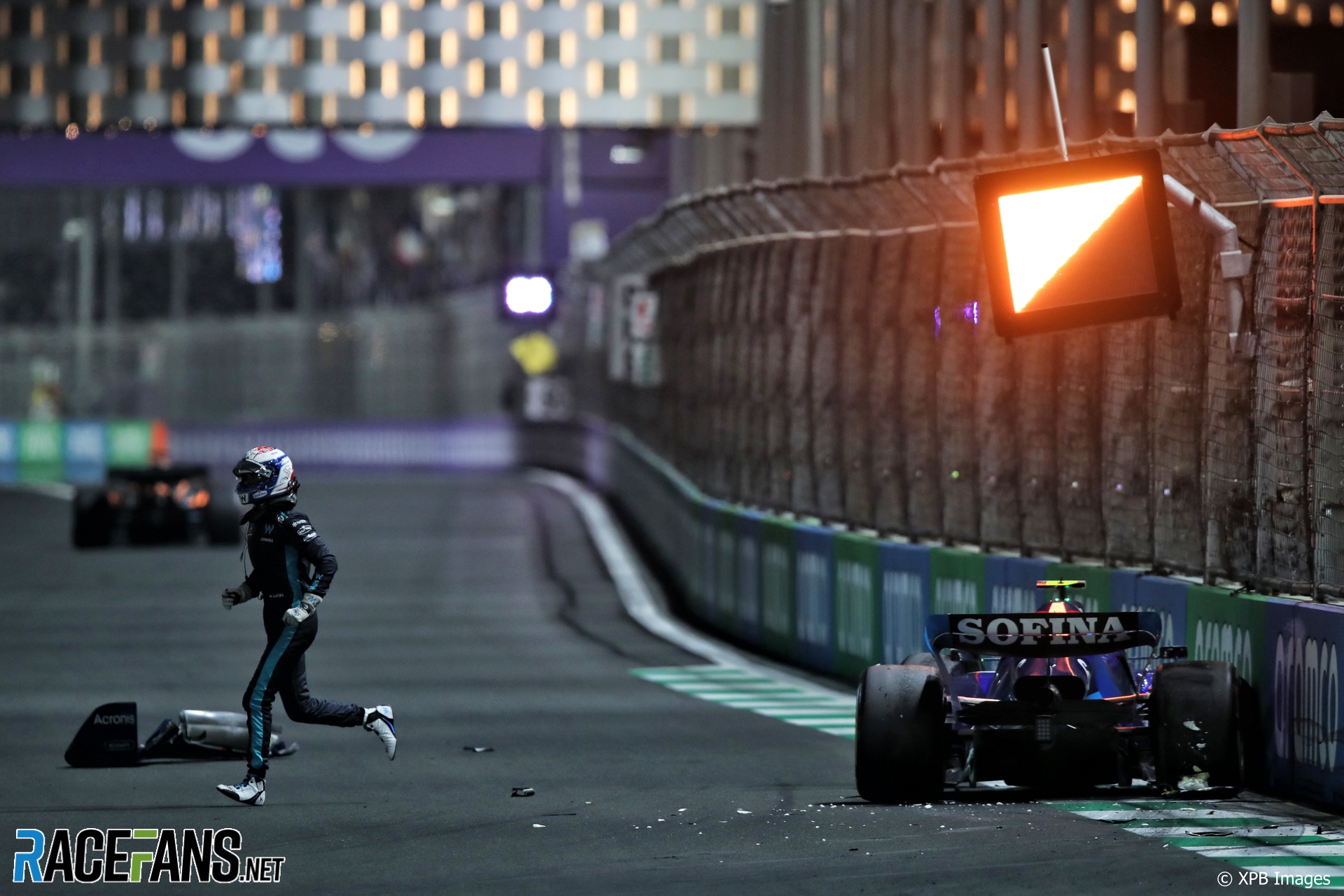The introduction of sweeping new technical regulations for the 2022 Formula 1 season was always going to make this a year of profound change for the series.
But other alterations besides new aerodynamics and tyre specifications are responsible for a fundamental change in the character of F1 racing.The latest car specifications are a significant step forward in safety over those which went before. Learnings have been taken from major accidents such as Romain Grosjean’s 2020 Bahrain shunt. Not to mention the tragic Formula 2 crash at Spa the year before, which claimed the life of Anthoine Hubert and left Juan Manuel Correa with serious injures.
But these safety improvements bring a performance cost. Impact absorption structures and anti-intrusion panels add mass. During the gestation of the new 2022 (previously 2021) rules the minimum weight level was raised repeatedly, and now stands at 798 kilograms, which is still below what some teams have been able to achieve.
Since Fernando Alonso made his F1 debut two decades ago F1 car weights have risen by around 25%. This has had an inevitable effect on their handling.

“We did an exhibition with the R25 in Abu Dhabi [two] years ago, and that car is 200 kilos lighter. So on TV, it felt very reactive and very sharp. I guess the heavier the cars are, the less feeling on TV of speed you get. So maybe that’s the consequence of these cars.
“But at the same time, they are very safe. The cockpit area has been reinforced a lot after the Grosjean accident in Bahrain. Also, the engines are a little bit more sustainable with the fuel.”
Advert | Become a RaceFans supporter and
While several drivers have commented on the ponderous performance of this year’s cars in low-speed corners, Alonso suspects the difference will be forgotten quickly enough.
“It is the same for everybody,” he said. “I think it’s just a matter of getting used to it. Maybe after eight or nine months, you don’t remember the last generation of cars.”
While F1 is making strides with the safety of its cars, the series has also become bolder with its approach to track design. It increasingly gives input into the layout of new tracks and changes to existing circuits.
The newest addition to the F1 calendar, Jeddah Corniche Circuit, was described by one driver as “definitely the most dangerous place on the calendar”. Drivers pressed for safety improvements between its first race in December last year and its return last month. But many of them also loved the challenge it offered.
Other venues F1 visited recently were radically reworked to make them quicker. Many of the changes were made with the 2022 cars in mind.
Yas Marina was overhaled just 12 years after the purpose-built facility opened, to do away with a series of slow corners and install quicker ones. The changes to Albert Park, scene of the last race, were in a similar vein. Multiple seconds were slashed off lap times at both venues.

The deaths of Ayrton Senna and Roland Ratzenberger during the 1994 San Marino Grand Prix at Imola, the next venue on the calendar, prompted a complete rethink in the sport’s approach to safety. A generation of new tracks were constructed with slower corners and larger, often asphalt run-offs. Existing venues were remodelled or even replaced.
In recent years quicker tracks have been embraced. Through radical safety advances such as the Halo, great strides have been made in allowing cars which reach over 300kph to withstand terrific impacts with their surroundings and each other.
Advert | Become a RaceFans supporter and
Haas driver Mick Schumacher emerged from a ferocious crash in Jeddah unharmed and would have been able to race the following day had his team been willing to risk their dwindling stock of spare parts. His team mate believes the kind of risk and reward offered by Jeddah is exactly what F1 should be about.

“There’s a reason that most drivers will say they love driving in Monaco because it’s high risk. There’s a direct consequence if you make a mistake. It just requires more of the driver. So I like that.”
Magnussen raved about Jeddah after his first visit to the track last month. “I loved driving in Jeddah,” he said. “That track is more extreme than most F1 tracks. It just feels so fast driving there, you really feel like you’re on the limit.”
He believes the sport has struck a good balance between ensuring drivers are punished for making mistakes without unnecessarily endangering them.
“The safety in the Formula 1 cars is so good these days, it’s improved massively and it continues to do so,” he said. “That’s all that work from the FIA and from GPDA has really paid off. I hope to see that trend continuing, I believe that it will.”
2022 F1 season
- Mercedes told me “you’re wrong” about 2022 car’s problems – Hamilton
- FIA confirms all 10 F1 teams complied with 2022 cost cap
- Steiner “not ashamed” of panning “slow” Schumacher in Drive to Survive
- Albon believes year out of F1 improved him as a driver
- Hamilton sees diversity gains in F1 years on from his ‘traumatising’ experience of racism





sumedhvidwans (@sumedhvidwans)
21st April 2022, 8:35
Increasing safety of cars isn’t supposed to allow unsafe tracks to join the calendar. One doesn’t cancel out the other.
Fast tracks are not a problem. Baku is a good example of balancing speed and safety. It is fast, severely punishes drivers, causes heavy accidents and very unpredictable races, but never endangers drivers. None of its corners are blind, the track becomes appropriately wide at high speed and has long escape roads at ends of long and fast straights.
Jeddah is a problem track. Blind corners, minimal run-offs, night time, make it easy to have multi-car crashes. I will reserve judgement on Vegas till we actually see how wide the track is. From the looks of it, it feels more Baku than Jeddah.
Jere (@jerejj)
21st April 2022, 9:50
@sumedhvidwans I agree & share your sentiments on everything, especially on one not cancelling out the other, but just want to point out the nighttime aspect is pretty irrelevant because floodlighting gives as much visibility as natural daylight, if not even more since artificial lighting stays consistent throughout, while natural light slightly varies depending on clouds, shadows from trees, buildings, other objects, etc.
Otherwise, Jeddah has some issues, but overall, I’m happy with that circuit.
Even Baku has a few slightly blind corners, but of course, not as many as Jeddah.
We’ll eventually find out how many similarities Vegas shares with the above two concerning runoffs, escape roads, track width at places, & turning angle-blindness, although certainly more Jeddah avg lap speed-wise.
Keith Campbell (@keithedin)
21st April 2022, 14:02
@sumedhvidwans In general I agree but Baku does have quite a dangerous pit entry that Martin Brundle, Nico Rosberg and others have drawn attention to. If Verstappen’s car had veered left instead of right when his tyre blew last year he could have had a head on collision with the concrete wall separating the pit lane from the track. I hope they can address that and make it safer.
anon
21st April 2022, 19:05
@keithedin despite the repeated criticism, there are currently no plans to change anything about the Baku circuit, including that wall at the end of the pit lane.
As others have noted, there does seem to be a return to the dangerous attitude that the cars are now safe enough to let them get away with taking more risks or slacken standards elsewhere. There was a reason that a number of those measures were put in place, and we’re already seeing in the Formula 2 races some of the injuries that F1 has sometimes avoided more by luck than by judgement – Bolukbasi’s recent concussion injuries in Jeddah come to mind.
I wonder what the impacts will be on Formula 2 too, given the attitude that circuit safety standards can be slackened because the F1 cars are safer. As a support series for Formula 1, Formula 2 races at many of those same circuits – but, although the performance might not be as high as an F1 car, the safety standards are also not as high either.
It does seem a bit concerning that the circuit risks are being pushed up, whilst there are concerns over a decline in the build quality of the latest Formula 2 cars – think about how many reports there have been of defective components on Formula 2 cars in recent years, some of which had serious safety ramifications (such as defective fuel tanks that were leaking fuel).
Ajaxn
21st April 2022, 18:19
Not only do we have recognisable unsafe tracks on the F1 calender, we’ve also reintroduced ‘ground effect’ dispite this being withdrawn in early 80s on safety grounds. Its like this sport can’t exist without the tragedies arising from greater and greater risks.
Biskit Boy (@sean-p-newmanlive-co-uk)
21st April 2022, 8:52
I love the high speed tracks, but sightlines need to be good else they are asking for trouble.
My biggest fear is qualifying when some cars are going very slowly and some cars are going very fast.
Ajaxn
21st April 2022, 18:21
“My biggest fear is qualifying when some cars are going very slowly and some cars are going very fast.”
https://en.wikipedia.org/wiki/Gilles_Villeneuve#Death
glynh (@glynh)
21st April 2022, 9:25
The heavier cars aren’t ideal but in general this is want I want from F1. With safer cars there’s more freedom with the track design so we can finally have less run off and have mistakes punished.
Tracks like Jeddah are brilliant to watch and I hope to see it’s approach to runoff (not visibility) copied at other tracks while keeping a variety of track designs.
Apophis (@apophisjj)
21st April 2022, 12:08
@glynh I think you dont understand what FIA’s intentions are. They didnt increase car safety in order for other things to become more “free”. This is exactly what they dont want. They just dont want another surprise like in Bianchi or Grosjean’s cases, because those are received very bad by the fans. They just want as little risks as possible. So dont expect tracks to have less run off because we wanted them since years and they have never come into place. Also, the only reason Jeddah went on was because of money. I m pretty sure that any other track that is not a money cow would have been called off if it had the “problems” Jeddah had.
Jon
21st April 2022, 12:33
I like that the cars are definitely much safer and the tracks are returning to being fast flowing similar to the tracks used during the first ground effect era. Also the heavy use of street circuits is great for the show. To me the cars look incredible at top speed most of the lap. I doubt many machines out there can do what F1 cars are capable of.
PeterG
21st April 2022, 18:08
I don’t agree at all.
There’s starting to be too many samey, flat, featureless dull (and now overly dangerous) street car park circuits now which add nothing to F1 apart from robbing fans of getting to watch F1 cars on some proper, exciting, historic natural terrain circuits that have a bit of character.
I’d much rather see circuits like Portmou, Istanbul, Hockenheim, Nurburbring, Magny-Course, Sepang, Kyalami on the calendar than a lot of these awful street circuits that are replacing them now.
The fact truly great circuits like Spa, Suzuka, Monza, Montreal, Melbourne & Silverstone are under threat of been replaced by these horrid street circuits is a travesty that F1 should be embarrassed and ashamed about.
mmertens (@mmertens)
21st April 2022, 13:29
Well, it’s a trade off. I certainly think nimbler cars are more exciting to watch, but at the same time, I’m really glad that the trend of off- camber-slow-corner-connected to a straight in a parking lot tilkedrome circuits are now being replaced by new venues that are more punishing and different. Also, the best thing of COVID was the fact that they had brought back some traditional and punishing tracks, as Imola, and also tried new “old tracks “ as Mugello too. The only thing that still concerns me is when they try to overhaul old tracks. To be honest, I still prefer the old Albert Track than the new one, it had more character and it was harder driving wise. Other than that, I rather having more Jeddah / Baku / Miami / Las Vegas layouts than Abu Dhabi / Korea / Russia / Valencia tracks, that’s for sure!
Andrew (@andrewsf1)
21st April 2022, 14:37
@keithcollantine
Instead of “terrific impacts” it should say “terrifying impacts”.
Pat Pepper
21st April 2022, 14:51
It’s ironic if safety advances are allowing new circuits to come onto the calendar with high-speed features, while the great high-speed tracks of yesteryear have either disappeared or, in cases like Silverstone, Monza and what used to be the Österreichring, are still around but are blighted by chicanes and other reconfigurations. It would be nice if the FIA considered these great old venues afresh with the view that “if it’s good enough for Jeddah, it should certainly be good enough for Monza etc”, and looked at ways of removing some of the chicanes and any other arrangements which were necessary in more dangerous times but might not be so necessary now. I’m not saying they are no longer necessary in every case, but at least examine what is possible.
Tommy C (@tommy-c)
22nd April 2022, 4:50
The thing with removing the chicanes in Monza would be that the circuit would be full throttle for almost the whole thing! Just a dab of the brakes for the lesmos and parabolica (sorry, Alboreto)! I’m not sure that’s an entirely bad thing though! Perhaps even bring back the banking…?
PeterG
21st April 2022, 18:14
The cycle repeats.
They will go to these dangerous circuits, Start thinking everything has become safe and then something will remind them that they are taking too many risks that will remind everyone just how unsuitable many of these horrible ultra fast and dangerous car park circuits are.
Pack racing was a great thrilling spectacle in Indycar and the cars safe enough that they kept doing it…… Up until the point warnings were ignored and a driver was killed.
Mark my words Liberty will be burned badly by this because eventually the unnecessarily dangerous car park circuits we seem to be getting now will bite back and someone is going to get hurt.
It’s the way things always go with this sport. You become lax and then comes the reminder and everything has to change.
Palaboran
21st April 2022, 18:43
Why don’t we return to pukka race tracks and drop all these concrete tunnels, barring Monaco and possibly Baku? The other street tracks all look like concrete tunnels and cheap computer graphics. If this is the future of F1 with the proportional reduction in classic tracks then I would rather live in the past.
some racing fan
22nd April 2022, 0:18
Jeddah IMO is the only circuit on the calendar that is totally objectionable in terms of safety- there are tracks from the 70’s that if they had concrete walls and had run-off areas smoothed out (some did) that are less dangerous than Jeddah. The old Interlagos, Brands Hatch, Watkins Glen, Mosport, Imola and Dijon circuits were never this dangerous. The biggest issue is how fast the cars go around there with the concrete walls being as close as they are. We all saw Mick Schumacher’s crash there: he got it wrong and there was a concrete wall only 30 feet away, and the impact was of course really violent.
Miami likely won’t have any safety issues, and we will have to see about Vegas and what they do about the medians of a few of those streets, which are already wide. And Jeddah wouldn’t be as objectionable if it had that same layout as a permanent track with proper run-offs. But it’s not. It’s a street circuit, with walls that are way, way too close, and that’s just too much.